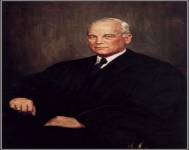Early life
Harold H. Burton was born in Jamaica, Mass., which is a suburb of Boston. His father was a professor and the first Dean of Students at the Massachusetts Institute of Technology. Burton attended public schools in Massachusetts for his primary education. After high school he went on to Bowdoin College, where he was the quarterback for the football team. In 1909, he graduated summa cum laude from Bowdoin. After graduating from Bowdoin he attended Harvard Law School, where he graduated from in 1912.
Career
After graduating from Harvard, Burton relocated to Cleveland, Ohio to begin work in private practice where he focused on corporate matters. After spending two years working in Cleveland, Burton moved to Salt Lake City, Utah to work in the legal department of Utah Power and Light Company. He later went on to work with the Idaho Power Company.
Burton left private practice to join the Army during World War I, while in the Army he rose to the rank of Captain. He served in the Army during 1917 and 1918. Burton was awarded a Purple Heart after being injured. After he completed his service, Burton went back to private practice, this time in Cleveland. By 1925 Burton became partner in his own firm, known as Cull, Burton and Laughlin. While working in private practice Burton also became a part-time professor at what is now known as Case Western Reserve.
In 1929, Burton served as an Ohio State House member. He was the mayor of Cleveland, Ohio between 1935 and 1940. While he was mayor, Burton earned the nickname “the Boy Scout Mayor,” because of his dedication for cleaning up Cleveland and increasing employment opportunities. After finishing his tenure as mayor he served as a United States Senator for Ohio from 1941 to 1945.
Supreme Court
When Harry S. Truman became president in 1945 after the death of President Franklin D. Roosevelt, he nominated Burton to the Supreme Court. An interesting choice for Truman considering he was a Democrat who nominated a Republican former Senator, Truman and Burton had become friends during their tenure as Senators.
In Morgan v. Virginia, Burton was the lone dissenter in the decision which invalidated a Virginia statute requiring racially segregated seating on buses that were involved in interstate travel. Burton dissented from this decision because he believed that it should be left up to Congress to “supply affirmative national uniformity of action.” Morgan v. Virginia, 328 U.S. 373, 392 (1946).
Burton wrote the majority opinion for Henderson v. United States, where the Court ruled that it was unlawful under the Interstate Commerce Act for an interstate commerce railroad to treat any person with prejudice or disadvantage. In Henderson, a black passenger who had a first-class ticket was denied the right to eat in the dining car when a white passenger was seated in the “black section” because of overflow. Burton wrote that the railroad’s use of “curtains, partitions and signs emphasize the artificiality of a difference in treatment which serves only to call attention to a racial [14] classification,” and that the railroad could not act in such a way under the Interstate Commerce Act. Henderson v. United States, 339 U.S. 816, 825 (1950).
Later years
After beginning to suffer from Parkinson’s disease, Burton retired from the court. After his retirement he served on the U.S. Court of Appeals for the District of Columbia by court designation until his death in 1964. He was 76.









